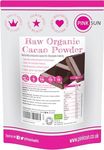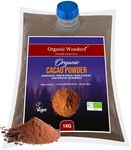Buying Guide for the Best Raw Cacao Powders
Choosing the right raw cacao powder can be a delightful yet overwhelming experience due to the variety of options available. Raw cacao powder is a versatile ingredient used in baking, smoothies, and other recipes, and it is known for its rich flavor and numerous health benefits. To make an informed decision, it's important to understand the key specifications and how they align with your needs and preferences.Cacao ContentCacao content refers to the percentage of cacao solids in the powder. This is important because it affects the flavor and nutritional profile of the product. Higher cacao content typically means a richer, more intense chocolate flavor and higher levels of antioxidants and nutrients. Cacao content can range from around 50% to 100%. If you prefer a milder taste, opt for lower cacao content. For a more robust flavor and greater health benefits, choose a higher cacao content.
Processing MethodThe processing method of cacao powder can impact its nutritional value and flavor. Raw cacao powder is minimally processed at low temperatures to preserve its natural nutrients, including antioxidants, vitamins, and minerals. This is important for those seeking the maximum health benefits from their cacao. If you are looking for the most nutrient-dense option, choose raw cacao powder over more heavily processed alternatives like Dutch-processed or roasted cacao powder.
OriginThe origin of the cacao beans can influence the flavor profile and quality of the cacao powder. Different regions produce beans with distinct flavors due to variations in climate, soil, and farming practices. Common origins include South America, Africa, and Southeast Asia. If you have a preference for a specific flavor profile, research the typical characteristics of cacao from different regions. For example, South American cacao is often fruity and floral, while African cacao tends to be more robust and earthy.
Organic CertificationOrganic certification indicates that the cacao powder is produced without the use of synthetic pesticides, herbicides, or genetically modified organisms (GMOs). This is important for those who prioritize consuming clean, environmentally friendly products. If you are concerned about chemical residues and environmental impact, look for cacao powder with a certified organic label.
Fair Trade CertificationFair Trade certification ensures that the cacao farmers receive fair wages and work under safe conditions. This is important for consumers who are concerned about ethical sourcing and supporting sustainable farming practices. If you want to contribute to social and economic justice for cacao farmers, choose cacao powder with a Fair Trade certification.
Flavor ProfileThe flavor profile of cacao powder can vary widely, from fruity and floral to nutty and earthy. This is important because it affects the taste of your recipes. To navigate the flavor profile, consider what you will be using the cacao powder for. If you are making desserts or sweet treats, you might prefer a cacao powder with a sweeter, more delicate flavor. For savory dishes or more intense chocolate experiences, a richer, more robust flavor might be ideal.
TextureThe texture of cacao powder can range from fine to coarse. This is important because it can affect the consistency of your recipes. Fine cacao powder dissolves more easily and is ideal for smooth beverages and delicate baked goods. Coarser cacao powder can add a bit of texture and is suitable for recipes where a more rustic feel is desired. Consider the types of recipes you will be making and choose a texture that complements them.















